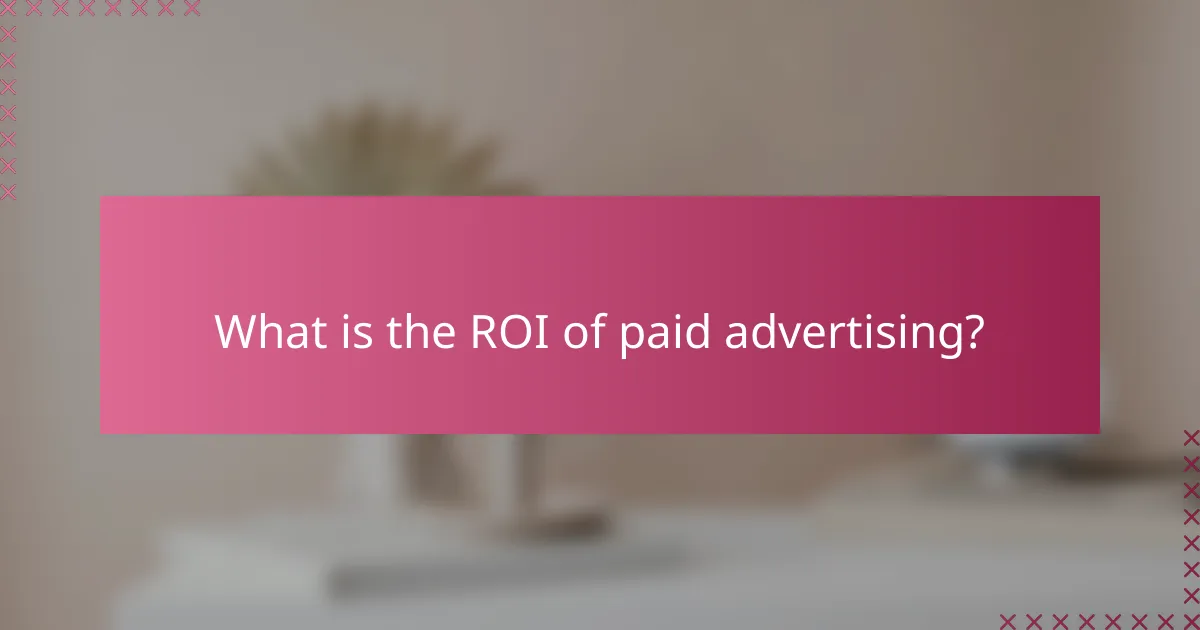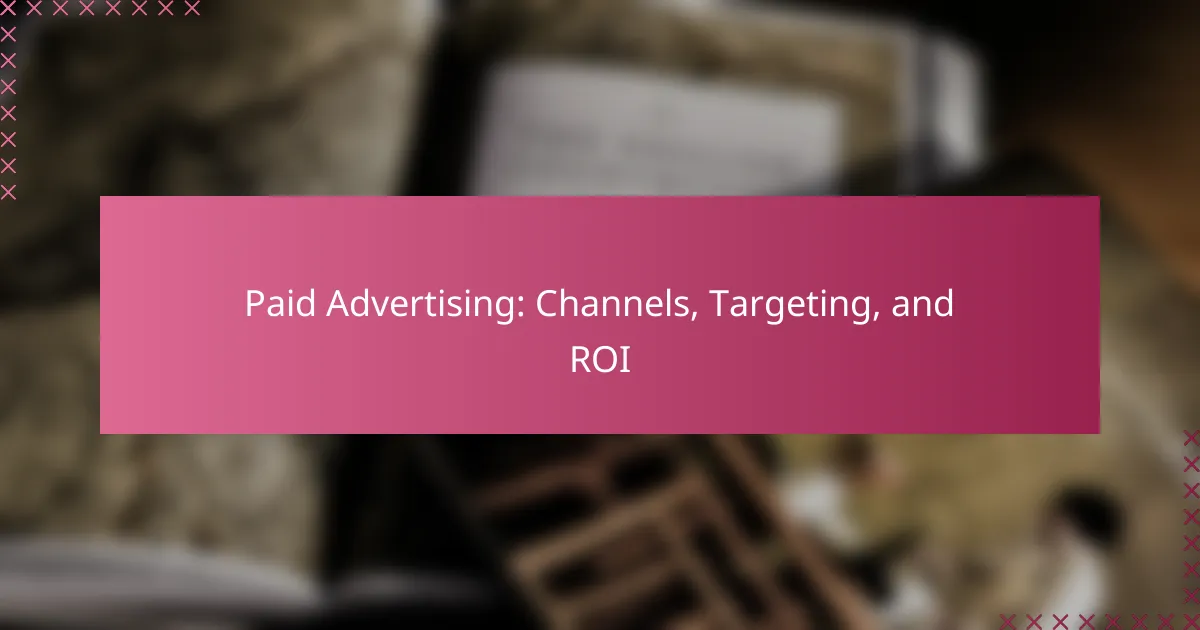Paid advertising offers a variety of channels, such as Google Ads, Facebook Ads, and Amazon Advertising, each designed to effectively reach specific audiences. By leveraging precise targeting strategies, businesses can engage individuals most likely to convert, ultimately enhancing ad performance. Understanding the return on investment (ROI) from these campaigns is crucial, as it allows companies to evaluate the profitability of their advertising efforts and refine their marketing strategies accordingly.

What are the best paid advertising channels for e-commerce?
The best paid advertising channels for e-commerce include Google Ads, Facebook Ads, Instagram Ads, Amazon Advertising, and LinkedIn Ads. Each channel has unique strengths and targeting capabilities that can help businesses reach their specific audience effectively.
Google Ads
Google Ads is a powerful platform that allows e-commerce businesses to display ads on Google’s search results and across its display network. Advertisers can target specific keywords, ensuring their products appear when potential customers search for related terms.
To maximize effectiveness, focus on high-intent keywords and use ad extensions to provide additional information. Regularly analyze performance metrics to adjust bids and improve ad copy for better conversion rates.
Facebook Ads
Facebook Ads enable e-commerce brands to reach a vast audience through targeted advertising based on user demographics, interests, and behaviors. This platform is particularly effective for visually-driven products, allowing businesses to showcase their offerings through engaging images and videos.
Utilize Facebook’s robust audience segmentation tools to refine targeting. A/B testing different ad formats and creatives can help identify what resonates best with your audience, improving overall ROI.
Instagram Ads
Instagram Ads, integrated with Facebook Ads, leverage visually appealing content to engage users. This platform is ideal for brands in fashion, beauty, and lifestyle sectors, where aesthetics play a crucial role in consumer decisions.
Focus on high-quality visuals and compelling captions. Utilize Instagram Stories for time-sensitive promotions, and consider influencer partnerships to expand reach and credibility among target demographics.
Amazon Advertising
Amazon Advertising is essential for e-commerce businesses selling on Amazon’s marketplace. It offers various ad types, including Sponsored Products and Sponsored Brands, which help increase visibility directly on product search results.
To succeed, optimize product listings with relevant keywords and high-quality images. Monitor advertising costs and sales data to adjust strategies, ensuring a profitable return on ad spend.
LinkedIn Ads
LinkedIn Ads are particularly effective for B2B e-commerce businesses targeting professionals and companies. This platform allows for precise targeting based on job titles, industries, and company sizes, making it suitable for niche markets.
Consider using Sponsored Content or InMail campaigns to engage with decision-makers. Crafting informative and value-driven content can enhance brand perception and drive leads effectively within the professional community.

How to target the right audience in paid advertising?
Targeting the right audience in paid advertising involves identifying and reaching individuals most likely to engage with your product or service. Effective targeting enhances ad performance and maximizes return on investment (ROI).
Demographic targeting
Demographic targeting focuses on specific characteristics of your audience, such as age, gender, income level, education, and marital status. By understanding these factors, advertisers can tailor their messages to resonate with particular groups. For instance, a luxury brand may target higher-income individuals aged 30-50.
When implementing demographic targeting, utilize platforms that allow you to filter audiences based on these attributes. Facebook Ads and Google Ads provide robust tools for this purpose, enabling precise audience segmentation.
Behavioral targeting
Behavioral targeting involves analyzing users’ online behavior, such as their browsing history, purchase patterns, and engagement levels. This method allows advertisers to reach users who have shown interest in similar products or services. For example, if a user frequently visits travel websites, they may be targeted with vacation package ads.
To effectively use behavioral targeting, consider employing tracking tools like cookies or pixels that gather data on user interactions. However, ensure compliance with privacy regulations, such as GDPR, when collecting and using this data.
Geographic targeting
Geographic targeting allows advertisers to reach audiences based on their physical location. This can be as broad as targeting entire countries or as specific as targeting neighborhoods. For example, a local restaurant may focus its ads on users within a 10-mile radius.
Utilize platforms that offer geo-targeting features, such as Google Ads and social media platforms. Adjust your messaging to reflect local culture or language, which can significantly improve engagement and conversion rates.
Retargeting strategies
Retargeting strategies focus on re-engaging users who have previously interacted with your brand but did not convert. This approach keeps your brand top-of-mind and encourages potential customers to return. For instance, showing ads to users who abandoned their shopping carts can lead to higher conversion rates.
Implement retargeting through platforms like Google Ads or Facebook Ads, which allow you to create custom audiences based on previous interactions. Monitor the performance of your retargeting campaigns to optimize ad frequency and messaging for better results.

What is the ROI of paid advertising?
The ROI of paid advertising measures the profitability of your advertising investments. It is calculated by comparing the revenue generated from ads to the costs incurred, helping businesses assess the effectiveness of their marketing strategies.
Average ROI statistics
On average, businesses can expect an ROI of around 4 to 5 times their advertising spend. However, this can vary widely depending on the industry, with some sectors achieving returns as high as 10 times their investment. Digital platforms often report higher ROI compared to traditional media.
Factors affecting ROI
Several factors influence the ROI of paid advertising, including the choice of platform, targeting accuracy, and ad quality. For instance, well-targeted ads on social media can yield better results than broad campaigns. Additionally, seasonal trends and market competition can significantly impact performance.
Budget allocation also plays a crucial role; investing more in high-performing channels can enhance overall returns. Regularly analyzing campaign data helps identify which factors are driving success and which need adjustment.
Calculating ROI for campaigns
To calculate ROI for paid advertising campaigns, use the formula: (Revenue – Cost) / Cost x 100. This will give you a percentage that reflects your return relative to your investment. For example, if you spent $1,000 on ads and generated $4,000 in revenue, your ROI would be 300%.
It’s essential to track all costs associated with the campaign, including creative development and management fees, to ensure an accurate calculation. Regularly reviewing these figures helps refine future advertising strategies and improve overall effectiveness.

What are the prerequisites for successful paid advertising?
Successful paid advertising requires clear objectives, a well-defined budget, and the selection of appropriate platforms. These elements ensure that campaigns are targeted effectively and yield a positive return on investment.
Defining campaign goals
Establishing clear campaign goals is essential for guiding your advertising efforts. Goals may include increasing brand awareness, generating leads, or driving sales. Each goal should be specific, measurable, achievable, relevant, and time-bound (SMART).
For example, instead of a vague goal like “increase sales,” specify “increase online sales by 20% over the next quarter.” This clarity helps in measuring success and adjusting strategies as needed.
Budget allocation
Determining your budget is crucial for effective paid advertising. Consider factors such as overall marketing budget, cost per click (CPC), and expected return on investment (ROI). A common approach is to allocate a percentage of your revenue or a fixed amount based on your goals.
For instance, businesses often allocate between 5-10% of their revenue to advertising. Monitor spending closely to ensure you stay within budget while maximizing impact.
Choosing the right platforms
Selecting the right advertising platforms is vital for reaching your target audience. Popular options include Google Ads, Facebook Ads, and LinkedIn Ads, each catering to different demographics and business objectives. Assess where your audience spends their time and which platforms align with your goals.
For example, if your target market is professionals, LinkedIn may be more effective than Instagram. Testing different platforms can provide insights into where your advertising performs best.

How to optimize paid advertising campaigns?
To optimize paid advertising campaigns, focus on refining targeting, enhancing ad content, and improving landing pages. This approach increases engagement and return on investment (ROI) while minimizing wasted ad spend.
A/B testing strategies
A/B testing involves comparing two versions of an ad to determine which performs better. Start by changing one element at a time, such as the headline or call-to-action, to isolate its impact on performance.
Consider running tests for at least one to two weeks to gather sufficient data. Aim for a sample size that reflects your audience to ensure reliable results. Common metrics to track include click-through rates (CTR) and conversion rates.
Ad copy optimization
Effective ad copy should be clear, concise, and compelling. Use strong action verbs and highlight benefits that resonate with your target audience. Incorporate relevant keywords to improve visibility and relevance.
Keep the tone consistent with your brand voice and ensure that the message aligns with the audience’s needs. Regularly review and update ad copy based on performance data to maintain engagement and relevance.
Landing page improvements
Landing pages should provide a seamless experience that matches the ad’s promise. Ensure that the design is clean, mobile-friendly, and loads quickly to reduce bounce rates.
Include clear calls-to-action and relevant information that guides users toward conversion. Utilize A/B testing on landing pages as well to identify which layouts and content drive the best results.
